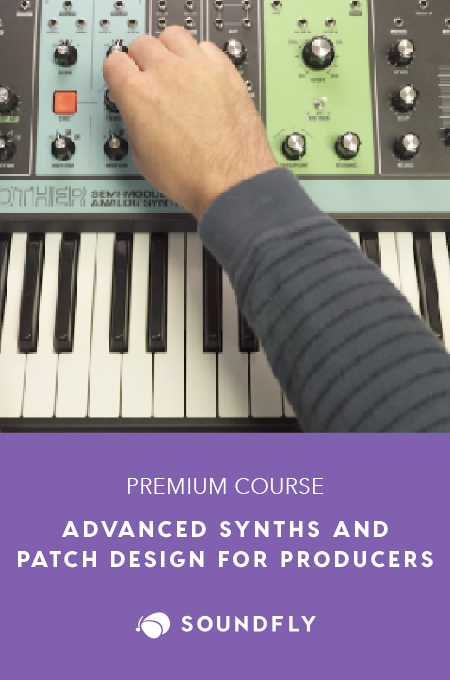+ This exclusive lesson is presented courtesy of Soundfly’s newest course, Elijah Fox: Impressionist Piano & Production. Sign up today to take your modern jazz piano and hip-hop beat making skills to new heights.
Throughout Elijah Fox’s course on Soundfly, he breaks down various songs and sketches he’s composed over the years, across his compositional, improvisational, or production mentalities.
In the following breakdown, Elijah walks us through some of the most interesting harmonic components of the titular track from his 2021 solo album, City in the Sky (Piano Works).
It’s an ethereal piece of music, evocative of the notion that within each of New York City’s skyscrapers are people living drastically different lives from one another who are still somehow bound by their longings and aspirations.
While Elijah may not necessarily have been conscious of that at the outset of the compositional process, it’s an idea that certainly corresponds with the piece’s use of repeated patterns of notes and parallel modalities.
+ Read more on Flypaper: “All (Human) Music Is Repetition — Let’s Talk About That.”
Mixing Modes
“City in the Sky” makes good use of modal mixture, a harmonic concept that occurs when a piece of music draws from more than one key center. You may be familiar with related terms like “borrowed chords,” and “modal interchange” as well.
In this case, the piece centers around two modes that are “parallel” to one another: C major and C natural minor (or C Ionian and C Aeolian).
Parallel Modes: Two or more modes that share the same tonic note.
The A Section
The A section of “City in the Sky” is anchored by two chords: A♭ major and F major. Here, those chords are pulled from the keys of C minor and C major, respectively — A♭ major being the ♭VI chord in C minor and F major being the IV chord in C major.
Seventh chords in the key of C minor:

Seventh chords in the key of C major:

The parallel relationship between C major and C minor is highlighted by the specific notes found in each of the repeated eight-note patterns that permeate the song’s A section.
This is that pattern played over A♭ major:

Over F major, we find a similar sequence of notes. However, while this one also begins with C, it replaces the E♭, A♭, and B♭ (notes pulled from the key of C minor) with their natural counterparts: E, A, and B (coming from the key of C major).

+ Learn production, composition, songwriting, theory, arranging, mixing, and more; whenever you want and wherever you are. Subscribe for full access!

The B Section
The B section of the song uses gentle flurries of sound and features the chords Cmaj7(#5) and Fmaj6. If you look closely at the notes within each voicing, you’ll see that these two chords have a lot in common with those used in the A section.

Notice how the notes in Elijah’s left hand move up as those played by his right hand move down.
An Interspersed Melody
In the spaces between those beautiful, floating patterns, “City in the Sky” features a delicate and dreamy melody. There’s a sort of give and take aspect created by these two key elements of the song, as though your ears are being gently rocked back and forth.
Listen to the clip below and feel free to hum along with that melody.
+ Read more on Flypaper: “A Beginner’s Guide to Chords and Modal Interchange.”
A Gospel Walk-Up
There’s one more section of the song and it uses harmonic motion reminiscent of the kind of “walk-up” we’re used to hearing in Gospel and similar styles.
In this case, Elijah’s progression is made up of the chords: A–, G, F#–7(♭5), E♭– (though he plays more of an E♭sus shape in the video), and D–.
Did you notice the contrary motion created as the top line moves up while the bass moves down?
Here’s something you can try yourself to practice some of these techniques in your playing.

Write a few measures of music using repeated note patterns in parallel modes.
In “City in the Sky,” Elijah’s repeated patterns are played in a way that has a similar sound to rolling a chord. You can give that a try or treat your patterns more like melodies, moving from note to note a bit more slowly.
Start by coming up with a six or eight note, repeatable pattern. Then, adjust the pattern with a parallel mode in mind. If you’re not sure where to start, go with a basic F major and F minor, but if you’d like to use other modes (e.g., Dorian, Lydian, etc.), that’s fine too.
Bonus: When you’re happy with your two patterns, explore different ways you might harmonize each of them, given the keys/modes you’ve used.
Remember, though “City in the Sky” is built on the keys of C major and C minor, those aren’t the actual chords in the song. Instead, Elijah’s repeated patterns are harmonized using other chords from those keys (like the A♭maj7 and Fmaj7 in the A section). If you come up with any ideas you really like, be sure to share them with us and the Soundfly community on Discord!
Play Your Heart Out!
Continue your learning adventure on Soundfly with modern, creative courses on songwriting, mixing, production, composing, synths, beats, and more by artists like Kiefer, Kimbra, Com Truise, Jlin, Ryan Lott, RJD2, and our newly launched Elijah Fox: Impressionist Piano & Production.




